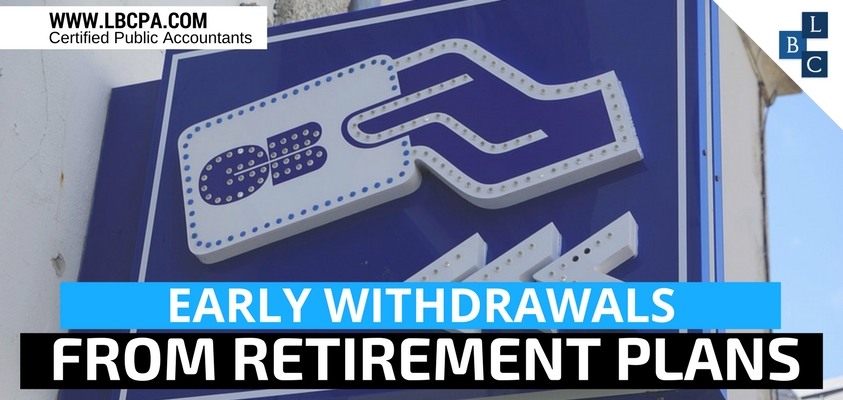LBCPA News 
Click here to go back
Early Withdrawals from Retirement Plans

Many people find it necessary to take out money early from their IRA or retirement plan. Doing so, however, can trigger an additional tax on top of income tax taxpayers may have to pay. Here are a few key points to know about taking an early distribution:
Early Withdrawals. An early withdrawal normally is taking cash out of a retirement plan before the taxpayer is 59½ years old.
Additional Tax. If a taxpayer took an early withdrawal from a plan last year, they must report it to the IRS. They may have to pay income tax on the amount taken out. If it was an early withdrawal, they may have to pay an additional 10 percent tax.
Nontaxable Withdrawals. The additional 10 percent tax does not apply to nontaxable withdrawals. These include withdrawals of contributions that taxpayers paid tax on before they put them into the plan. A rollover is a form of nontaxable withdrawal. A rollover occurs when people take cash or other assets from one plan and put the money in another plan. They normally have 60 days to complete a rollover to make it tax-free.
Check Exceptions. There are many exceptions to the additional 10 percent tax. Some of the rules for retirement plans are different from the rules for IRAs.
File Form 5329. If someone took an early withdrawal last year, they may have to file Form 5329, Additional Taxes on Qualified Plans (Including IRAs) and Other Tax-Favored Accounts, with their federal tax return. Form 5329 has more details.
Use IRS e-file. Early withdrawal rules can be complex. IRS e-file is the easiest and most accurate way to file a tax return. The tax software that taxpayers use to e-file will pick the right tax forms, do the math and help get the tax benefits they are due. Seven out of 10 taxpayers qualify to use IRS Free File tax software. Free File is only available through the IRS website at IRS.gov/freefile.
More information on this topic is available on IRS.gov.
Taxpayers should keep a copy of their tax return. Beginning in 2017, taxpayers using a software product for the first time may need their Adjusted Gross Income (AGI) amount from their prior-year tax return to verify their identity. Taxpayers can learn more about how to verify their identity and electronically sign tax returns at Validating Your Electronically Filed Tax Return.
If you have any questions regarding accounting, domestic taxation, international taxation, IRS representation, U.S. tax implications of Real Estate transactions or financial statements, please give us a call at 305-274-5811.
Source: Thomson Reuters






